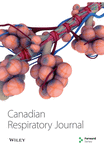The Descriptive Epidemiology of Primary Lung Cancer in an Alberta Cohort with a Mutivariate Analysis of Survival to Two Years
Abstract
BACKGROUND: Lung cancer contributes significantly to cancer morbidity and mortality. Although case fatality rates have not changed significantly over the past few decades, there have been advances in the diagnosis, staging and management of lung cancer.
OBJECTIVE: To describe the epidemiology of primary lung cancer in an Alberta cohort with an analysis of factors contributing to survival to two years.
PATIENTS AND METHODS: Six hundred eleven Albertans diagnosed with primary lung cancer in 1998 were identified through the Alberta Cancer Registry. Through a chart review, demographic and clinical data were collected for a period of up to two years from the date of diagnosis.
RESULTS: The mean age at diagnosis was 66.5 years. The majority of cases (92%) were smokers. Adenocarcinoma, followed by squamous cell carcinoma, were the most frequent nonsmall cell lung cancer histologies. Adenocarcinoma was more frequent in women, and squamous cell carcinoma was more frequent in men. The overall two- year survival rates for nonsmall cell, small cell and other lung cancers were 24%, 10% and 13%, respectively. In multivariate analysis, stage, thoracic surgery and chemotherapy were significantly associated with survival to two years in nonsmall cell carcinoma; only stage and chemotherapy were significant in small cell carcinoma.
CONCLUSIONS: This study provides a Canadian epidemiological perspective, which generally concurs with the North American literature. Continued monitoring of the epidemiology of lung cancer is essential to evaluate the impact of advances in the diagnosis, staging and management of lung cancer. Further clinical and economic analysis, based on data collected on this cohort, is planned.




